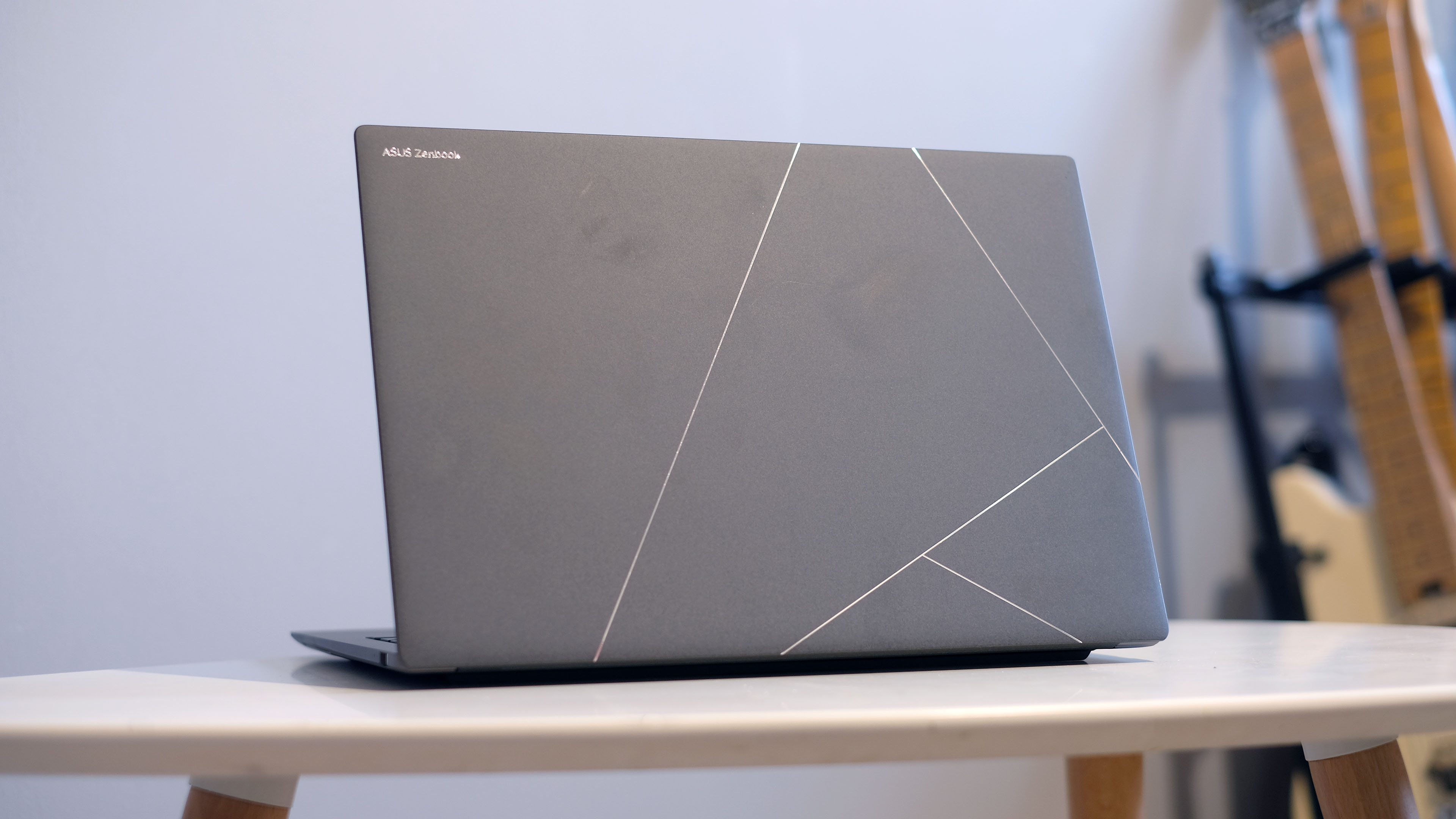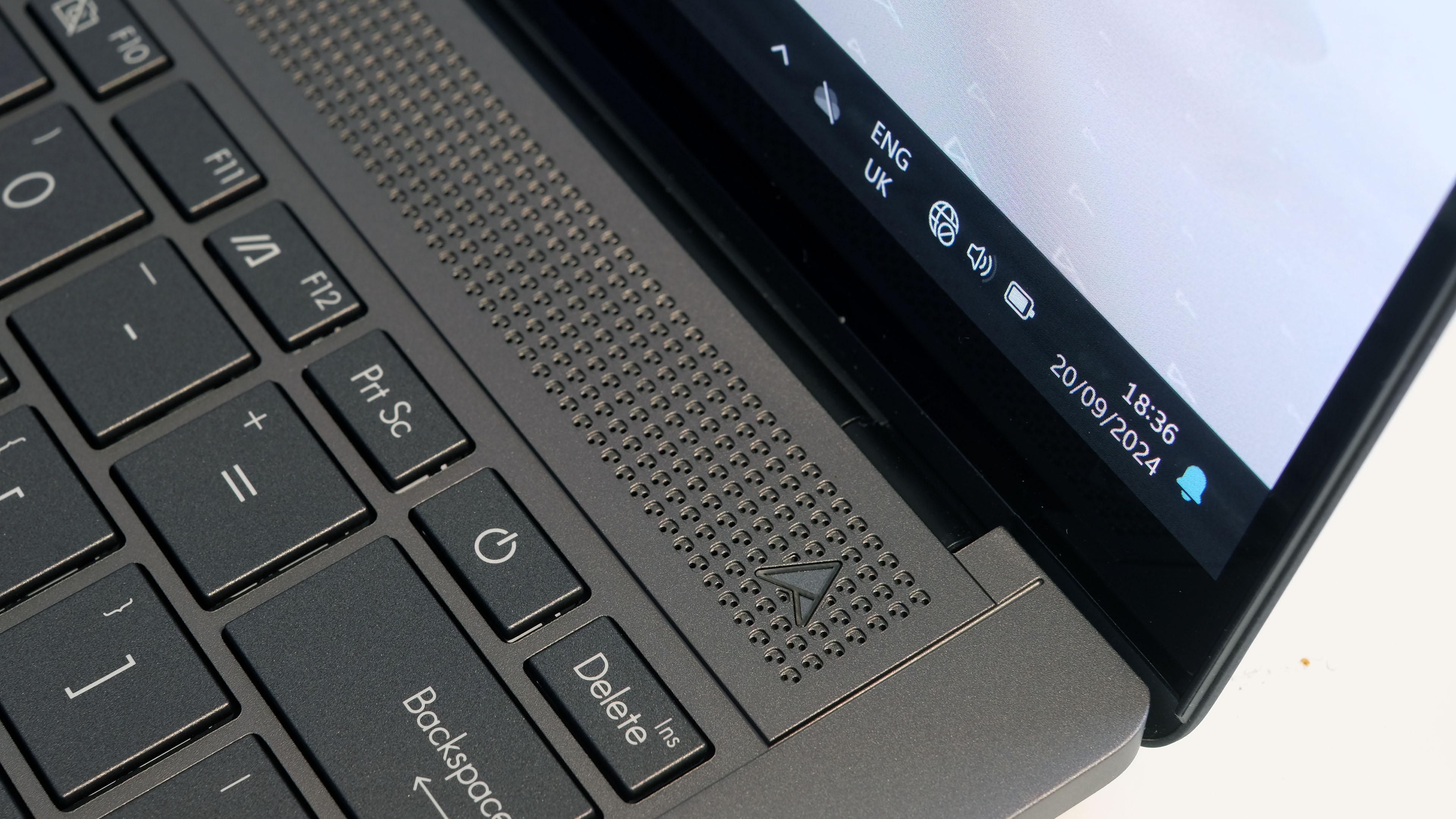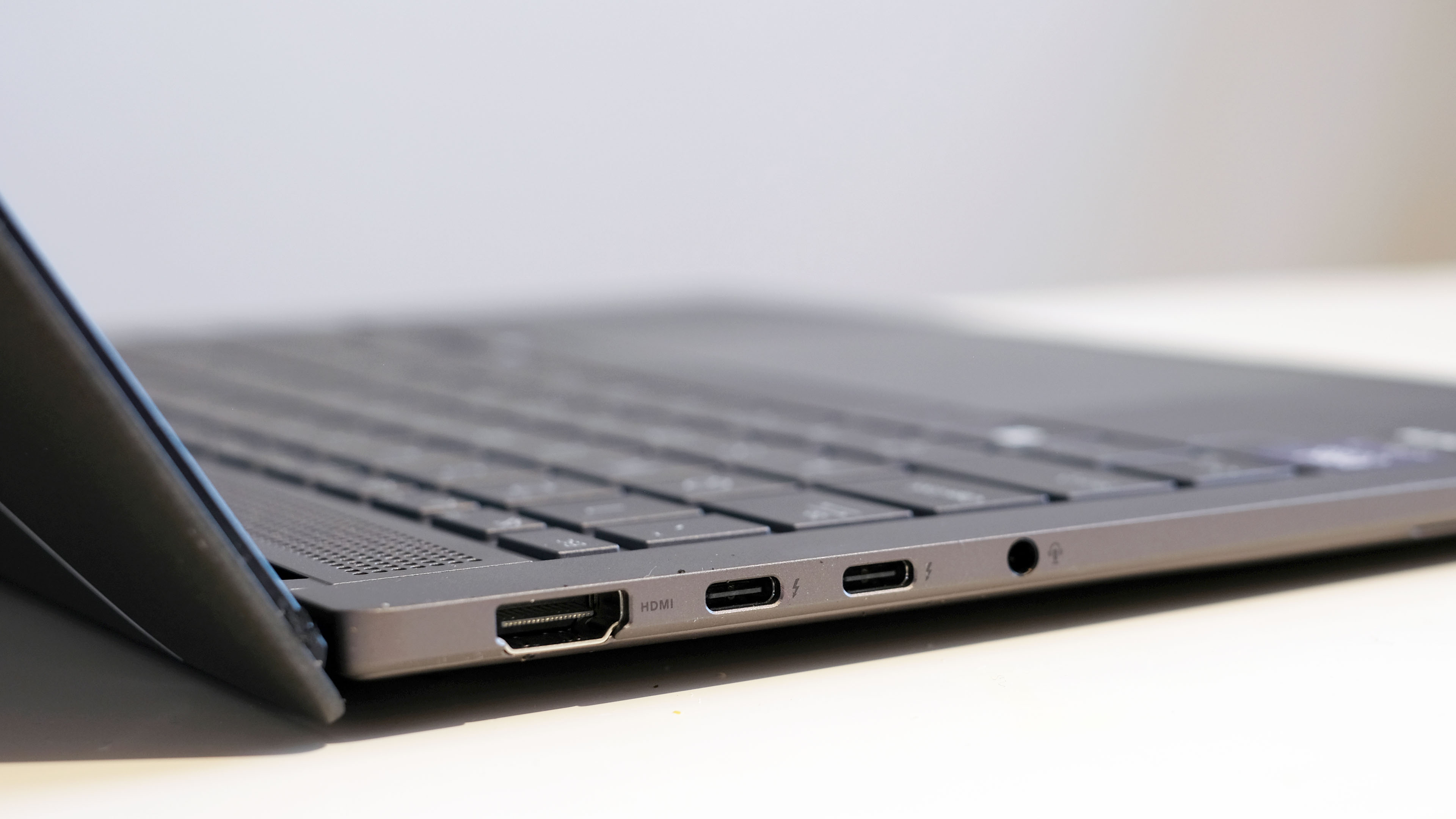Asus Zenbook S14 review: astounding all-rounder showcases Intel's latest in style
Housing Intel's Core Ultra Series 2, the Asus Zenbook S14 is a great portable laptop that can deliver on-the-go gaming goods too

The Asus Zenbook S14 OLED shows Intel’s new generation of laptop brains isn’t about standard-setting CPU speed. But the combo of awesome battery life, low noise and punchy integrated graphics offers the kind of breadth these slim and light models should be all about. A more substantial keyboard would be welcomed, but this PC will try on all the hats you throw its way, and look good in doing so.
-
+
A surprisingly compelling portable gaming PC
-
+
Super-long battery life
-
+
Loud speakers
-
+
Quiet operation
-
-
Too-slim keyboard
-
-
Sometimes slow-to-silence fans
-
-
Peak CPU performance ain’t all that
Why you can trust T3

When did the world of laptops get so fast-paced? It only seems yesterday we were looking at the first Intel Ultra laptops, now Asus has rocked up with our first Intel Ultra 2 laptop (read about what those are here): the Asus Zenbook S14 OLED (codename 'UX5406').
What gives? These Ultra 2 PCs are a reaction to the "made for AI" laptops, a rival to Qualcomm's Snapdragon X Elite chipset-toting PCs (again, read about what this is and why it matters here), which include the Asus Vivobook S 16.
We're witnessing a civil war here folks, and it makes recommending the best laptops a truly fraught job. The good news? The Asus Zenbook S14 OLED has truly awesome battery life, even when used outdoors with the screen maxed-out. It's better for gaming than its rivals too.
However, its CPU chops aren’t quite as good as the best out there. We have a feeling this will improve in the next generation, but the Zenbook S14 OLED is still arguably one of the best all-rounders out there for the kind of person who should buy one of the best lightweight laptops. Here's why:
Asus Zenbook S14 OLED UX5406: Price & Availability
The Asus Zenbook S14 OLED launched in mid-September 2024, and was available in stores shortly after. The range’s RRP starts at £1299/$1499 (there's no Australia pricing I can find, but an AU$2250 equivalent is about right), for the model with an Intel Ultra 5 processor, 16GB RAM and 512GB SSD.
That’s enough for most folks, but its graphics and CPU power will be a little worse than our review sample’s – which is the slightly pricier version with Intel Ultra 7 CPU, 1TB SSD and 32GB RAM. There's also an Intel Ultra 9 chipset variant, which is the priciest – but you don’t get extra RAM or storage, that upgrade just brings slightly elevated performance.
Asus Zenbook S14 OLED UX5406 review: Design

The Asus Zenbook S14 OLED leans into one of the main strengths of these new Intel Lunar Lake laptops: they are a portability dream. It has a 14-inch screen, and is both slim and light.
Like other Asus Zenbook models, this one has an angular style. The keyboard keys are severe squares, the heat grille above isn't like anything you'd find on one of the best MacBooks or a Microsoft Surface.
Oh, and the lid is inlaid with a geometric pattern that is more involved than you might guess. Asus calls this finish Ceraluminium. The top-most layer is ceramic, but those stark lines reveal the bright, raw aluminium underneath. It's not easy to stand out when making a laptop. Not without doing something ridiculous, anyway. And Asus certainly is trying.
Build quality is also excellent. The screen is stiff, and there's just the tiniest amount of flex when you press down on the middle of that heat grille above the keyboard. That passes my tests – and I've seen many of ultra-wobbly ones over the years.
Asus hasn't forgotten practicality in the Zenbook's connections either. Yep, it's a slimline array, but we do get a USB-A, a full-size HDMI, and a 3.5mm headphone jack. Some manufacturers leave those out these days. Those ports are accompanied by a couple of super-fast Thunderbolt 4 connectors that can be used to radically expand connectivity using a dock.
Asus Zenbook S14 OLED UX5406 review: Display

You know what's frustrating about these early made-for-AI laptops? They all have excellent screens, to the extent there’s barely anything of note to separate them.
Here, it's a 2880 x 1800 pixel OLED that measures 14-inches across the diagonal. It's a glossy touchscreen, and while there's no mega anti-reflective layer aboard, it was bright enough to let me write a chunk of this review on one of summer 2024's final bright and sunny days.
The hinge rotation is quite limited, though. This screen can't lean back more than the bog-standard 130-degrees or so, but this does help to dramatically cut down on screen wobble when you work on a less-than-solid surface.
Colour is fantastic, as is contrast. This is a touchscreen too, and it has a glass surface, avoiding the wobbly reflections seen in some plastic top-layer displays. Max refresh rate is 120Hz too. All boxes are ticked, bar the kind of extreme brightness you can get in some Mini-LED laptops, like the MacBook Pro line.
Asus Zenbook S14 OLED UX5406 review: Keyboard & Touchpad

You can instantly tell Asus was out to make a "no compromise" first impression with the Zenbook S14 OLED. It has a fairly expensive-feeling keyboard and touchpad, and those keys have a lovely yet slightly soft-roughened texture to them.
I do like this keyboard for typing, and find the rigidity and density of the lower casing works wonders for avoiding the hollow feel some laptop keyboard have. Can you tell there's a "but" coming, though?
The Asus Zenbook S14 OLED keyboard combines fairly slimline travel with darker, less clicky actuation feedback. I'm a fan of the latter, but not so much when it's combined with the former. As is so often the case with these style and portability-driven PCs, I just wish there were a bit more travel to these keys.
There ain’t much substance here, which you do get in the other launch Intel Ultra 2 showcase – the Lenovo Yoga 7i (not the Yoga 7x, which houses Snapdragon X Elite). It does have an incredibly bright keyboard backlight, though, should you want to be to see those keys even better in daylight.
The touchpad is only a middleweight contender too. It’s of a good size, it’s glass and is non-glitchy. But I find its action a bit slow and stiff, although it certainly has the substance the keyboard lacks.
Fan of haptic pads? This isn’t one, meaning there’s the classic dead zone up top. You can also use gestures along its extreme sides to control volume and brightness. But it’s hardly a reason to buy one of these PCs when keyboard shortcuts buttons do the same job.
Asus Zenbook S14 OLED UX5406 review: Performance

The Asus Zenbook is the first laptop we've reviewed with an Intel Core Ultra 7 258V processor. This is a second-wave Ultra, and it is miles removed from the first in how it operates. But you won't necessarily tell that from how it runs day-to-day.
This is an eight-core CPU, with an Intel Arc GPU on-board, just like the first-gen Intel Ultra chipsets.
On the graphics side we get a chunk more performance. But for raw number crunching there really isn’t much of a generational gain here at all, because these 2nd series Ultra laptop brains are all about ramping up efficiency.
The issue here is the recent Qualcomm Snapdragon X Elite does offer both cracking CPU performance and efficiency. But it also lacks a couple of important characteristics of the Asus Zenbook S14 OLED.
The Asus absolutely steamrolls those Snapdragon laptop when playing games. We spent hours playing around with this thing. You can play The Witcher 3 at Ultra settings, 1200p resolution, for example. Sure, you’ll want to stick to 30fps frame rates, but it looks awesome even in 2024.

Cyberpunk 2077 is easily playable with a bit of tweaking at Full HD-grade resolutions. And, as Alien: Isolation’s sequel was announced at the time of review, we tried to that too. At 1080p resolution, with everything maxed, we averaged 102fps.
Sure, it’s not going to replace one of the best gaming laptops for the self-identifying “true gamers” out there. But unlike a “real” gaming PC, the Asus Zenbook S14 OLED gets this performance running on battery, hardly makes any noise while playing, and still lasts 2.5 hours off a charge when you’re doing your level best to melt the GPU. It’s better performance and better stamina than a Steam Deck.
The Asus Zenbook S14 OLED also doesn’t suffer from the rare-but-annoying compatibility issues seen in Qualcomm Snapdragon laptops. I’ve had a small handful of issues with peripherals and software with those PCs, but nothing of the sort here.
This laptop stays quiet too, even when the fans are running. A light whir just kicks up when you stress the CPU, start gaming or download a stack of data. The only issue is that because this whole design is based around limited-heat components that don’t need a mega fan array, those fans can take a while to shut off once the Asus Zenbook S14 OLED warms up.
Asus Zenbook S14 OLED UX5406 review: Battery Life & Features

That’s not to say the Asus Zenbook S14 OLED is not impressively efficient, mind. I’ve tested the battery life in a whole bunch of ways. Writing an article outdoors with the screen maxed, you can expect up to 15 hours of use.
Basic indoors video streaming or work? Up to 18 hours and change. Or, as noted earlier, that can drop down to around 2.5 hours when you’re maxed out with gaming or another activity that pushes the processor to its max. But that's still good, in context.
In certain situations you’ll get better battery life from a MacBook Air, because of the way Apple has control over the entire hardware and software structure. But for the kind of jobs for which these super-light laptops excel, the Asus Zenbook S14 OLED has killer battery life.
It does not have a killer webcam, though. Sure, it’s a 1080p resolution camera, but ends up looking pretty soft and low-detail unless it has plenty of light to work with. Most home lighting won’t cut it, but there is an IR emitter that lets it work for face-recognition login.
The Asus Zenbook S14 OLED speakers, however, are pretty good. We get four Harman Kardon-branded drivers, good maximum volume and that rare thing in Windows laptops: a sense of actual bass.
Default settings make the use of dynamic loudness and volume normalisation far too obvious – the default mode doesn’t have that MacBook sense of balance. But you can tweak that as it’s just a software adjustment.
Verdict

As the debut of Intel’s new Core Ultra Series 2-series processors, the Asus Zenbook S14 OLED shows off this new family in a great light.
It sure makes a great do-it-all PC for everyone but those who need peak number-crunching performance. While the Zenbook S14 OLED isn’t bad in this area, it is beaten by the latest MacBook and Qualcomm Snapdragon X Elite models.
What you get in return, however, is better gaming performance and (in my experience) none of the compatibility issues inherent to the Qualcomm Snapdragon X Elite laptops’ unusual tech back-end. For some that'll make this Intel choice the 5-star option.
Also consider
The roster of laptops with these new Intel Ultra processors will no doubt fill out soon. But for now your other big option is the Lenovo Yoga Slim 7i Gen 9. This is a much larger 15-inch laptop, and therefore a little less portable-friendly. It does have a far more meaty keyboard than the Asus’s, though, with 1.5mm key travel.
Outside of Intel you’ll be looking at the array of Qualcomm Snapdragon X Elite laptops. The Lenovo Yoga 7X Slim is a great alternative that, again, has a better keyboard. But, as with all these Qualcomm models, you do risk some compatibility issues and graphics/gaming performance is a league or two below.
If you don’t need too much storage, the base Microsoft Surface Laptop 7 is a great cheaper contender. But is 256GB enough these days? For many it isn’t.
Fans of matte screens should also check out the Acer Swift 14 AI. It has a strange LED indicator that lights-up when you use AI features – totally pointless – but does have a reflection-minimising display and is well priced.
Sign up to the T3 newsletter for smarter living straight to your inbox
Get all the latest news, reviews, deals and buying guides on gorgeous tech, home and active products from the T3 experts

Andrew is a freelance tech and entertainment journalist. He writes for T3, Wired, Forbes, The Guardian, The Standard, TrustedReviews and Shortlist, among others.
Laptop and computing content is his specialism at T3, but he also regularly covers fitness tech, audio and mobile devices.
He began writing about tech full time in 2008, back when the Nintendo Wii was riding high and smartphones were still new.
-
 Polar’s new subscription feature lands in the shadow of Garmin’s Connect+ rollout
Polar’s new subscription feature lands in the shadow of Garmin’s Connect+ rolloutPR genius or timing disaster? Polar’s new Fitness Programme adds adaptive training to its ecosystem
By Matt Kollat Published
-
 New Orient Star watches offer a glimpse of the magic within
New Orient Star watches offer a glimpse of the magic withinThere are two new skeleton pieces
By Sam Cross Published
-
 Netflix's most surprising 100%-rated sci-fi series returns with gorgeous trailer
Netflix's most surprising 100%-rated sci-fi series returns with gorgeous trailerLove Death + Robots is back for more
By Max Freeman-Mills Published